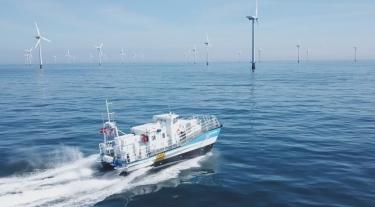The high-performance, 15 meter long SES daughter craft employs an air cushion for active motion damping, resulting in access capabilities beyond conventional daughter craft vessels, whilst reducing fuel consumption and improving crew and passenger comfort during transit. The compact size also enables vessel deployment using a conventional 15 tonne davit crane fitted onto a mothership. The vessel is designed for launch and recovery operations, however the Sea Puffin will be operated from port during this initial phase of testing and operation.
The Sea Puffin vessel, designed by Norwegian company ESNA, received initial support from the Carbon Trust’s industry-led collaborative research, development and deployment programme in 2016. The backing from the OWA successfully de-risked the design to improve its launch and recovery capabilities, as well as ensuring that the vessel’s performance conformed to the operational requirements of the developers. The OWA has continued its support of the Sea Puffin through funding WindPartner to undertake these trials and to help get the vessel built and to market.
Dan Kyle Spearman, Manager of Offshore Wind Access Systems, the Carbon Trust, commented, “The rapid progress of the Sea Puffin from concept to sea trials is another great example of collaborative research and development where industry and innovators are able to partner together to deliver state of the art, relevant vessels for the future of the industry.”
Trygve H Espeland, Naval Architect and co-founder of ESNA added, “The reduction of fuel consumption compared to other daughter craft or crew transfer vessels will help the operators of wind farms to significantly reduce emissions and the environmental footprint of O&M activities for many years to come.”
The sea trials, conducted by the vessel owner WindPartner, will demonstrate that the ‘Sea Puffin 1’ can work in an operational wind farm environment in preparation for charter and full commercial operation in mid-August.
”The Sea Puffin Daughter Craft concept offers much more cost effective access during construction, operation and maintenance of offshore windfarms” says CEO, WindPartner, Mr. Morten Mellerud.
WindPartner and ESNA have a long-term cooperation agreement with the ambition to build a series of this vessel type over the next few years.
ENDS
Notes to editors
The ‘Sea Puffin 1’ was built at Esbjerg Shipyard in Denmark, and delivered to independent ship-owner, WindPartner last month. ENOVA and Innovation Norway also supported the construction phase. Support was also provided by the Regional Research Council Agder (RFFAgder) and The Sørlandet Knowledge Foundation (SKF).
About the Offshore Wind Accelerator
The Offshore Wind Accelerator (OWA) is Carbon Trust's flagship collaborative RD&D programme. The joint initiative was set up between the Carbon Trust and nine offshore wind developers in 2008. The current phase involves nine offshore wind developers; these OWA partners account for 76% of Europe’s installed offshore wind capacity. The OWA programme aims to reduce the cost of offshore wind to be competitive with conventional energy generation, as well as provide insights regarding industry standard (and best practice) health and safety requirements.
The OWA is part funded by the Scottish Government with the remaining funding coming from industry. The Carbon Trust's OWA industrial partners are nine international energy companies EnBW, E.ON, Equinor, innogy SE, Ørsted, Scottish Power Renewables/Iberdrola, SSE Renewables, Shell, Vattenfall Wind Power.
Read more on the Offshore Wind Accelerator
For further information, please contact:
Ainslie Macleod, Senior PR Manager, at the Carbon Trust press office on 020 7170 7050 or email ainslie.macleod@carbontrust.com.


